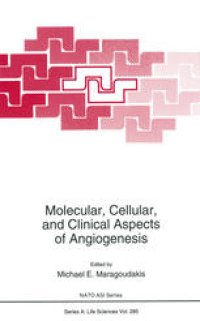
Ebook: Molecular, Cellular, and Clinical Aspects of Angiogenesis
- Tags: Pharmacology/Toxicology, Biochemistry general, Animal Anatomy / Morphology / Histology, Plant Sciences
- Series: NATO ASI Series 285
- Year: 1996
- Publisher: Springer US
- Edition: 1
- Language: English
- pdf
There has been an explosion of research activity related to angiogenesis in recent years, and hundreds of laboratories worldwide are actively involved in many aspects of angiogenesiS. The literature on angiogenesis increases exponentially every year, and more than 16,000 peer-reviewed articles have been published the past 25 years, which are scattered in basic science and clinical journals. The complexity of the cascade of events leading to new vessel formation from preexisting ones has challenged scientists in cell biology, biochemistry, physiology, pharmacology, molecular biology, developmental biology, and other fields. With their multidisciplinary approach and the powerful new techniques that have been developed, the progress in understanding angiogenesis has been impressive indeed. Only 12 years ago the mention of an angiogenic factor caused skepticism. Today we have the complete amino-acid fiequence and their genes cloned for at least 9 angiogenic factors. Many laboratories are studying their role in angiogenesis, and several biotechnology firms have a keen interest in commercial developments relative to these molecules. The role of extracellular matrix components in angiogenesis and the interaction of endothelial cells with other cell types such as pericytes, smooth muscle cells, and inflammatory cells have been studied by other groups. This rapid expansion is the result of a realization that in many disease states a common underlying pathology is a derangement in angiogenesis.
Heterogeneity of Endothelial Cells: On the Possible Role of Endothelial Cell Heterogeneity in Angiogenesis; P.I. Lelkes, et al.Role of Extracellular Matrix in Angiogenesis: Plasminogen Activators in Fibrinolysis and Pericellular Proteolysis. Studies on Human Endothelial Cells in vitro; V.W.M. van Hinsbergh, et al.AngiogenicFactors and Their Receptors: Basic Fibroblast Growth Factor Expression in Endothelial Cells: An Autocrine Role in Angiogenesis? A.Gualandris, et al. The Biology of Vascular Endothelial Growth Factor; N. Ferrara.Physiological Angiogenesis: Angiogenesis in the Female Reproductive Organs; L.P. Reynolds, et al.Pathological Angiogenesis: Tumor Oxygenation and Tumor Vascularity: Evidence for Their Clinical Relevance in Cancer of the Uterine Cervix and Considerations on Their Potential Biological Role in Tumor Progression; M. Hockel, et al.Inhibitors of Angiogenesis: A Heparanaseinhibitory, bFGFbinding Sulfated Oligosaccharide That Inhibits Angiogenesis ex ovo Has Potent Antitumor and Antimetastatic Activity in vivo; R.J. Tressler, et al.Biotechnological Aspects of Angiogenesis: A Method for the in vivo Quantitation of Angiogenesis in the Rabbit Corneal Model; R.W.Shaffer, M. Friedlander. 13 additional articles. Index.
Heterogeneity of Endothelial Cells: On the Possible Role of Endothelial Cell Heterogeneity in Angiogenesis; P.I. Lelkes, et al.Role of Extracellular Matrix in Angiogenesis: Plasminogen Activators in Fibrinolysis and Pericellular Proteolysis. Studies on Human Endothelial Cells in vitro; V.W.M. van Hinsbergh, et al.AngiogenicFactors and Their Receptors: Basic Fibroblast Growth Factor Expression in Endothelial Cells: An Autocrine Role in Angiogenesis? A.Gualandris, et al. The Biology of Vascular Endothelial Growth Factor; N. Ferrara.Physiological Angiogenesis: Angiogenesis in the Female Reproductive Organs; L.P. Reynolds, et al.Pathological Angiogenesis: Tumor Oxygenation and Tumor Vascularity: Evidence for Their Clinical Relevance in Cancer of the Uterine Cervix and Considerations on Their Potential Biological Role in Tumor Progression; M. Hockel, et al.Inhibitors of Angiogenesis: A Heparanaseinhibitory, bFGFbinding Sulfated Oligosaccharide That Inhibits Angiogenesis ex ovo Has Potent Antitumor and Antimetastatic Activity in vivo; R.J. Tressler, et al.Biotechnological Aspects of Angiogenesis: A Method for the in vivo Quantitation of Angiogenesis in the Rabbit Corneal Model; R.W.Shaffer, M. Friedlander. 13 additional articles. Index.
Content:
Front Matter....Pages i-ix
On the Possible Role of Endothelial Cell Heterogeneity in Angiogenesis....Pages 1-17
Gene Expression and Endothelial Cell Differentiation....Pages 19-29
Co-Expression of the ?2-Subunit of Laminin and the Metastatic Phenotype in Melanoma Cells....Pages 31-36
Plasminogen Activators in Fibrinolysis and Pericellular Proteolysis. Studies on Human Endothelial Cells in Vitro....Pages 37-49
The Effect of Ionizing Radiation on Endothelial Cell Differentiation and Angiogenesis....Pages 51-60
Basic Fibroblast Growth Factor Expression in Endothelial Cells: An Autocrine Role in Angiogenesis?....Pages 61-72
The Biology of Vascular Endothelial Growth Factor....Pages 73-83
Scatter Factor As a Potential Tumor Angiogenesis Factor....Pages 85-94
The Role of Thrombin in Angiogenesis....Pages 95-103
The Role of Thrombospondin in Angiogenesis....Pages 105-113
Signal Transduction Pathways and the Regulation of Angiogenesis....Pages 115-123
Angiogenesis in the Female Reproductive Organs....Pages 125-139
Angiogenesis in Skeletal Muscle....Pages 141-150
Wound Healing Angiogenesis: The Metabolic Basis of Repair....Pages 151-159
Wound Healing, Fibrin and Angiogenesis....Pages 161-172
Tumor Oxygenation and Tumor Vascularity: Evidence for Their Clinical Relevance in Cancer of the Uterine Cervix and Considerations on Their Potential Biological Role in Tumor Progression....Pages 173-179
Role of Scatter Factor in Pathogenesis of Aids-Related Kaposi Sarcoma....Pages 181-189
Role of the Early Response Gene Cyclooxygenase (Cox)-2 in Angiogenesis....Pages 191-198
Inhibitors of Angiogenesis in Human Urine....Pages 199-211
Factitious Angiogenesis III: How to Successfully Endothelialize Artificial Cardiovascular Bioprostheses by Employing Natural Angiogenic Mechanisms....Pages 213-227
A Method for the in Vivo Quantitation of Angiogenesis in the Rabbit Corneal Model....Pages 229-239
Back Matter....Pages 241-253
....Pages 255-298